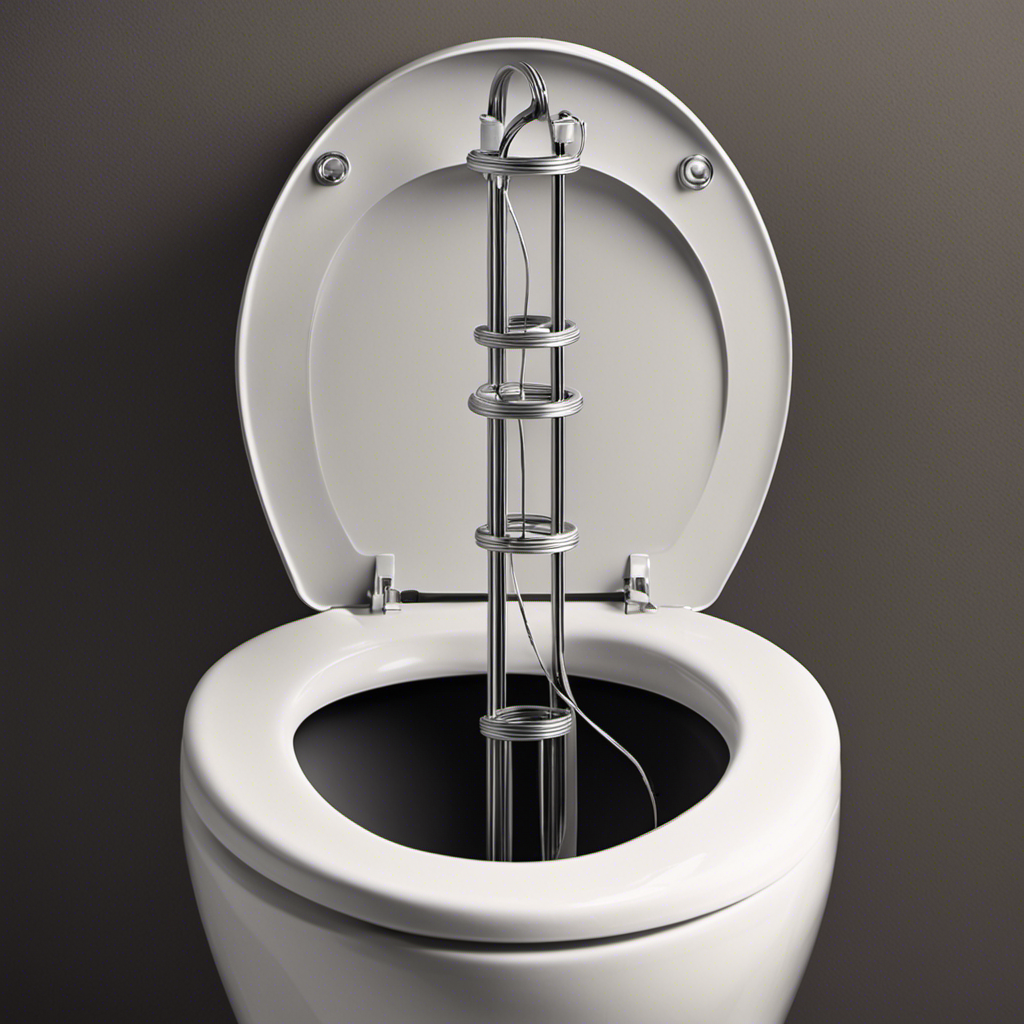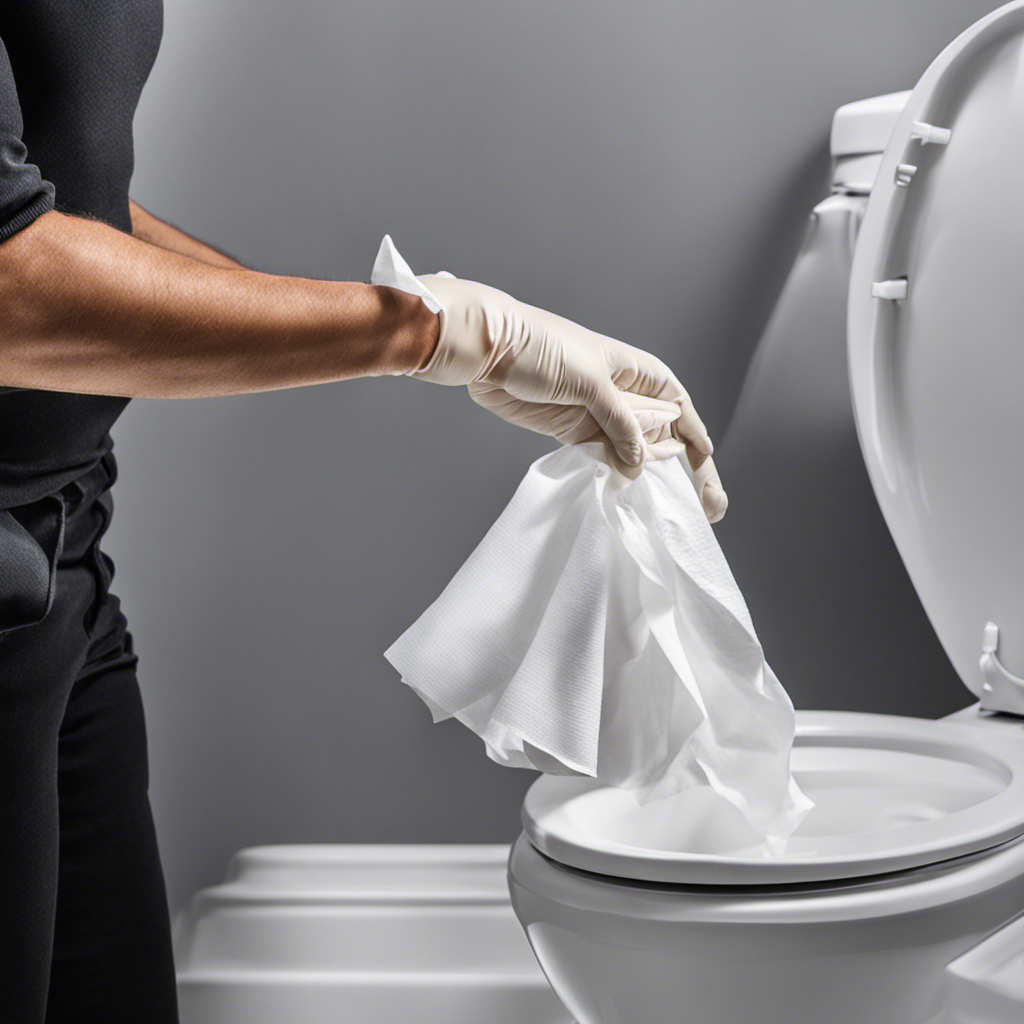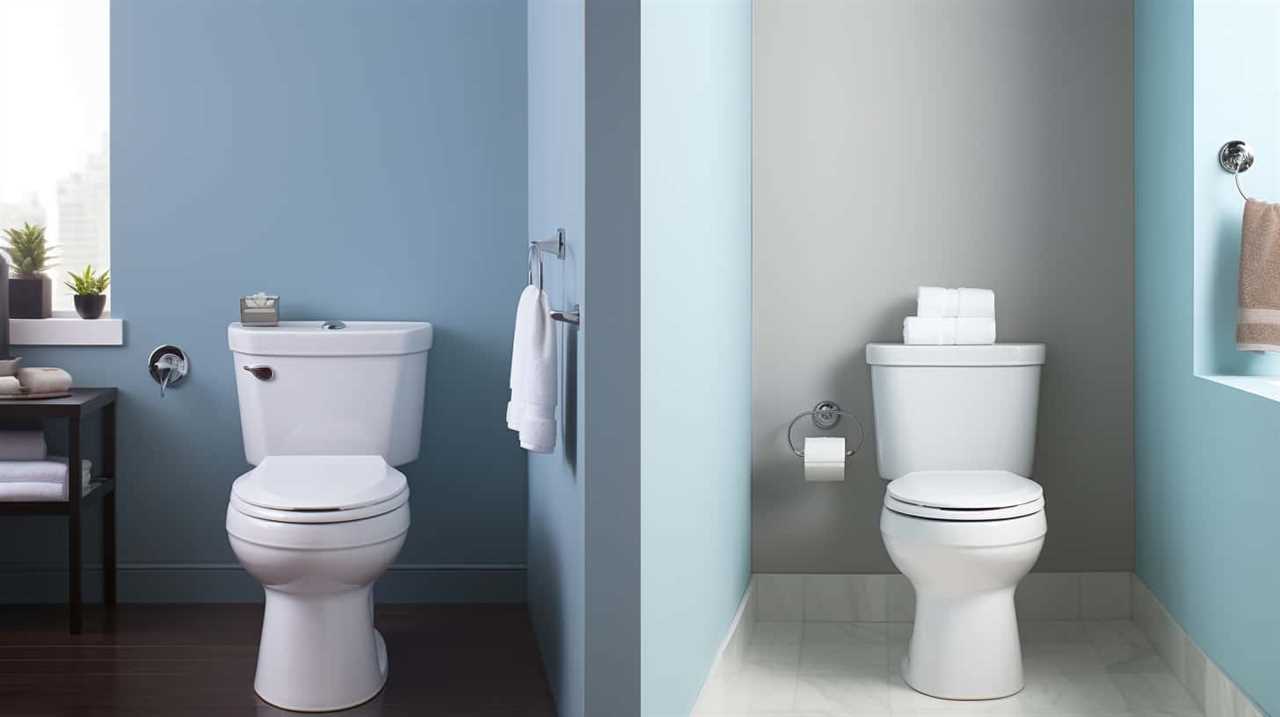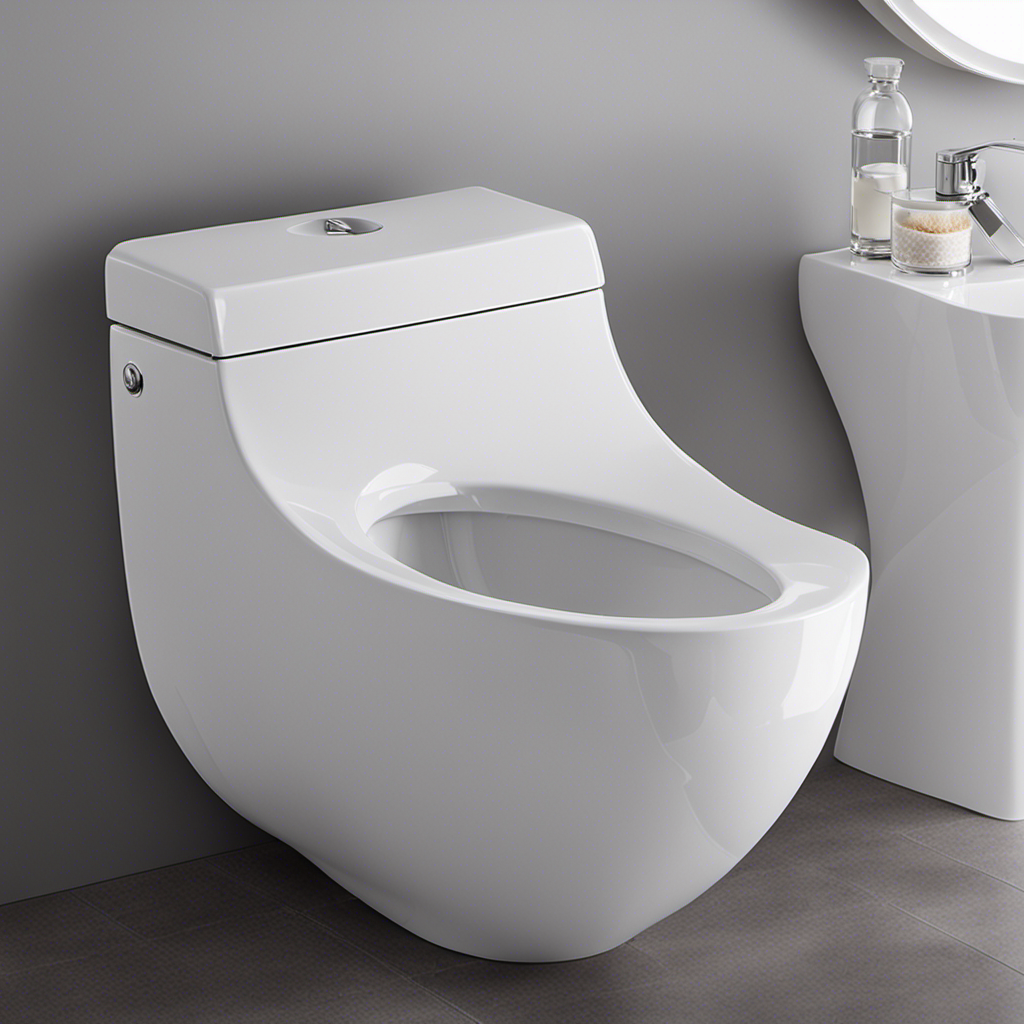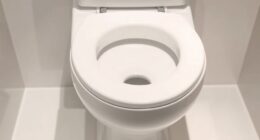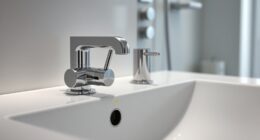Hey there!
Have you ever found yourself in a sticky situation with a clogged toilet and no plunger in sight? Well, fear not! I’m here to share some handy techniques to help you unclog your toilet without the need for a plunger.
In this article, I’ll guide you through various methods, including the hot water method, the baking soda and vinegar technique, and even using a wire hanger or plumbing snake.
So, let’s dive right in and get your toilet back in working order!
Key Takeaways
- Assess the severity of the clog by observing the water level and drainage.
- Gather necessary tools and materials such as rubber gloves, hot water, a toilet brush or wire coat hanger, and dish soap.
- Try unclogging methods like using hot water, baking soda and vinegar, a wire hanger or plumbing snake, or a wet/dry vacuum.
- If DIY methods fail, consider calling a professional plumber to prevent further damage and costly repairs.
Assess the Severity of the Clog
You should start by checking how severe the clog is. Assessing the clog severity is essential in determining the most suitable unclogging method.
First, observe the water level in the toilet bowl. If it is near the rim or overflowing, the clog is severe.
Next, flush the toilet to see if the water drains properly. If it doesn’t, the clog is likely deep within the pipes.
If the water drains slowly but doesn’t overflow, the clog may be less severe. In such cases, alternative unclogging methods can be effective. These methods include using dish soap and hot water, a wire coat hanger, or a wet/dry vacuum.
Once you have assessed the severity, you can move on to gather the necessary tools and materials for unclogging the toilet.
Gather Necessary Tools and Materials
To get started, gather all the necessary tools and materials for unclogging the toilet without using a plunger. When it comes to natural remedies and DIY solutions, it’s important to have everything ready before attempting to fix the clog.
First, you’ll need a pair of rubber gloves to protect your hands from any potential mess.
Next, grab a bucket and a large jug of hot water. The hot water will help break down any blockages in the pipe.
Additionally, you’ll need a toilet brush or a wire coat hanger to manually remove the clog if necessary.
Lastly, keep a bottle of dish soap handy as it can act as a lubricant to help loosen the blockage.
With these tools and materials, you’ll be ready to tackle the clog head-on.
Use the Hot Water Method
Using the hot water method with a large jug of hot water is a simple and effective way to break down blockages in the pipe. I have found this method to be quite successful in unclogging toilets without the need for a plunger. To ensure safety and avoid any mishaps, it is important to follow certain precautions when using hot water for unclogging purposes.
- Make sure the water is not boiling hot, as it can potentially damage the toilet bowl or pipes.
- Use a sturdy and heat-resistant container to hold the hot water, such as a plastic jug or bucket.
- Pour the hot water slowly and steadily into the toilet bowl, aiming for the center of the blockage.
If the hot water method doesn’t work for you, there are a few alternative unclogging methods you can try.
- Using a toilet auger or snake to manually break up the blockage.
- Using a mixture of baking soda and vinegar to create a chemical reaction that can dissolve the clog.
- Contacting a professional plumber if the blockage persists or if you’re unsure about handling the situation yourself.
Try the Baking Soda and Vinegar Technique
When faced with a clogged toilet and lacking a plunger, one effective solution is to try the baking soda and vinegar technique.
This method relies on a chemical reaction between the two ingredients to unclog the toilet, making it a natural and environmentally-friendly alternative to using a plunger.
With simple ingredients that are commonly found in most households, this technique offers a convenient and cost-effective solution to a clogged toilet.
Chemical Reaction Unclogs Toilet
You can easily unclog your toilet using a chemical reaction. Instead of relying on a plunger, there are alternatives that can effectively clear the blockage.
One popular method is to use a combination of baking soda and vinegar, which creates a powerful reaction that can break down the clog. Here’s how it works:
- Pour one cup of baking soda into the toilet bowl.
- Slowly add one cup of vinegar to the bowl.
- Allow the mixture to sit for about 30 minutes.
- Flush the toilet to see if the clog has cleared.
This chemical reaction creates a bubbling effect that helps to dislodge and dissolve the blockage. It’s important to note that this method may not work for all types of clogs, particularly those caused by large objects or excessive waste. In such cases, it’s best to consult a professional plumber for assistance.
Natural Alternative to Plunger
If you’re in a bind and don’t have a plunger, there’s a natural alternative that can help clear your clogged toilet. Natural remedies are a DIY toilet unclogging solution that can effectively tackle the problem without the need for harsh chemicals or expensive tools.
One simple and effective solution involves a combination of two common household ingredients: baking soda and vinegar. To begin, pour about one cup of baking soda into the toilet bowl. Next, slowly add one cup of vinegar. The mixture will create a chemical reaction, causing bubbles and fizzing.
Allow the solution to sit for about 30 minutes to an hour. Finally, flush the toilet to see if the clog has been cleared. This natural alternative is a safe and cost-effective way to unclog your toilet without a plunger.
Simple Ingredients, Effective Solution
Using just baking soda and vinegar, a simple mixture can effectively clear clogs in your toilet without the need for a plunger. This simple solution provides a quick fix to a common household problem.
Here’s how it works:
- Pour one cup of baking soda into the toilet bowl.
- Follow it with two cups of vinegar.
- Let the mixture sit for about 30 minutes.
- The chemical reaction between the baking soda and vinegar creates a fizzy foam that helps break down the clog.
- After 30 minutes, flush the toilet to see if the clog is cleared.
- If necessary, repeat the process until the clog is completely cleared.
This method is not only effective but also environmentally friendly, as it doesn’t involve the use of harsh chemicals. It’s a simple and affordable alternative to using a plunger, providing a quick fix for toilet clogs.
Use a Wire Hanger or Plumbing Snake
To unclog a toilet without a plunger, start by using a wire hanger or plumbing snake. When it comes to wire hanger alternatives, a plumbing snake is a reliable option.
A plumbing snake, also known as a drain auger, is a long, flexible tool designed to remove clogs from drains and pipes. Its benefits are numerous.
Firstly, a plumbing snake can reach deep into the toilet drain, ensuring effective removal of the blockage. Secondly, it has a spiral-shaped end that grabs onto the clog, allowing you to pull it out easily. Lastly, a plumbing snake is made of durable materials, making it a long-lasting and cost-effective solution.
Utilize a Wet/Dry Vacuum
When faced with a stubbornly clogged toilet and no plunger in sight, fear not! I have discovered a clever solution using a wet/dry vacuum as a substitute.
By creating a proper seal around the toilet bowl drain, the vacuum can effectively remove the blockage with its strong suction power.
This method is not only efficient but also prevents any potential mess or damage caused by using alternative tools.
Vacuum as Plunger Substitute
If you don’t have a plunger, you can try using a vacuum to unclog the toilet. Although not a traditional method, a wet/dry vacuum can be an effective alternative when faced with a stubborn clog. However, it is important to follow certain precautions to ensure vacuum safety and prevent any damage.
Here are some key points to keep in mind when using a vacuum as a plunger substitute:
- Use a wet/dry vacuum specifically designed for water and debris removal.
- Make sure the vacuum is clean and free from any dirt or debris.
- Attach a suitable attachment, such as a rubber or plastic nozzle, to create a seal.
- Start with low suction power and gradually increase if needed.
- Avoid using a regular household vacuum cleaner, as it may not be designed for liquid or solid waste.
Effective Toilet Unclogging
Using a wet/dry vacuum can be an effective way to clear stubborn clogs in the bathroom. When it comes to toilet maintenance, prevention measures are crucial. However, clogs can still occur despite our best efforts.
In such cases, a wet/dry vacuum can come to the rescue. To start, ensure that the vacuum is in ‘wet’ mode to handle any water present in the toilet bowl. Next, create a tight seal between the vacuum hose and the drain opening. This will help to create a strong suction and effectively remove the clog. Once the seal is secure, turn on the vacuum and let it do its work.
Remember to never flush the toilet while the vacuum is in use, as it may cause a mess. Regular toilet maintenance and prevention measures can help minimize the occurrence of clogs, but having a wet/dry vacuum handy can provide a reliable solution when clogs become stubborn.
Call a Professional Plumber if All Else Fails
You should definitely consider calling a professional plumber if all else fails to unclog the toilet. While there are many DIY methods to try first, sometimes the blockage is just too stubborn or complex to handle on your own.
Here are a few reasons why calling a plumber is the best solution:
- Experience: Plumbers have the necessary expertise and equipment to efficiently diagnose and fix any toilet clogging issue.
- Safety: Dealing with a clogged toilet can be messy and potentially hazardous, especially if you’re not familiar with the proper techniques and precautions.
- Prevent further damage: Attempting to unclog the toilet yourself can sometimes worsen the problem or cause damage to the plumbing system, leading to more costly repairs in the long run.
Frequently Asked Questions
Can I Use a Plunger if I Have One, or Is It Necessary to Use Alternative Methods?
I can use a plunger if I have one, but it’s not necessary. There are alternative methods to unclog a toilet. Using hot water can be effective, but cold water can also work. Pros and cons depend on the situation.
Can I Use Cold Water Instead of Hot Water for the Hot Water Method?
I wouldn’t recommend using cold water instead of hot water for unclogging toilets. Hot water helps to break down the clog more effectively. However, there are alternative methods to unclog toilets if you don’t have hot water available.
Can I Use Any Type of Vinegar for the Baking Soda and Vinegar Technique?
Yes, I can use any type of vinegar for the baking soda and vinegar technique. However, it’s important to note that different types of vinegar may have different strengths and odors, so it’s best to choose one that suits your preference.
Is It Safe to Use a Wire Hanger or Plumbing Snake in My Toilet Without Causing Damage?
Using a wire hanger or plumbing snake in a toilet can be risky. To avoid damage, exercise caution and follow proper procedures. It’s important to understand the potential risks and take necessary precautions.
Can I Use a Regular Vacuum Instead of a Wet/Dry Vacuum to Try and Unclog My Toilet?
I can use a toilet auger as an alternative method for unclogging a toilet with no plunger. It’s important to be careful and follow instructions to avoid causing any damage.
Conclusion
In conclusion, unclogging a toilet without a plunger may sound daunting, but with the right techniques and tools, it can be a manageable task.
By assessing the severity of the clog and using methods like the hot water technique, baking soda and vinegar combination, or a wire hanger, you can effectively clear the blockage.
If all else fails, don’t hesitate to call a professional plumber for assistance.
Remember, just like a skilled conductor leading an orchestra, you too can master the art of unclogging toilets without a plunger.
